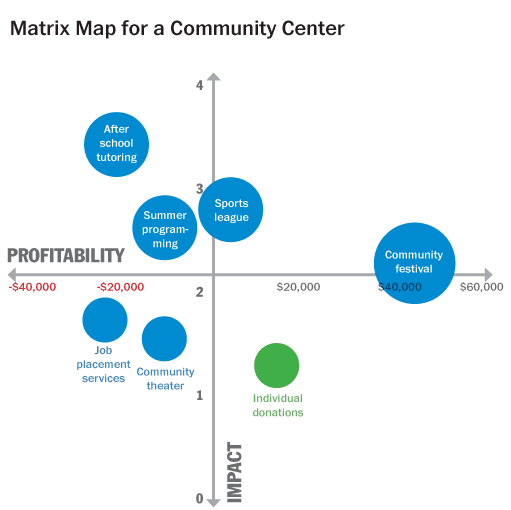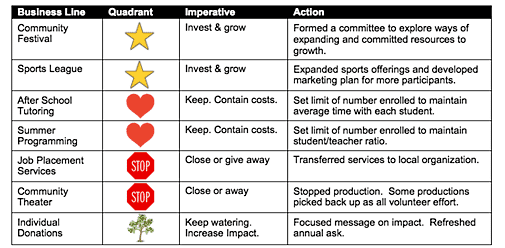Matrix Map Part Two: The Strategic Imperatives
Beyond helping nonprofit leaders understand the business model, the Matrix Map can help you strengthen it.

In this article, Steve Zimmerman continues a presentation of the Matrix Map model from the book Nonprofit Sustainability: Making Strategic Decisions for Financial Viability.
The “dual-bottom line of nonprofits”
In our last Blue Avocado column, we introduced the Matrix Map, which you can use to create a visual representation of your organization’s business model. Comprised of all your organization’s business lines (activities), the Matrix Map illustrates how your activities work together towards both programmatic impact and financial viability.
For many board members, the Matrix Map provides sudden clarity on how the organization’s different activities inter-relate. But beyond helping them understand the business model, the Matrix Map can help nonprofit leaders strengthen it.
You’ll recall that putting together a Matrix Map calls for plotting your organization’s business lines according to their mission impact and financial profitability. Depending on where an activity is placed on the map, a strategic imperative emerges. These strategic imperatives are the actions that would most likely strengthen the business model and increase the organization’s sustainability.
The Matrix Map below for a community center shows that the after-school tutoring program has the highest impact and is subsidized by the community festival and individual donations. The map showcases the integration between mission impact and financial profitability, or what is sometimes called the dual-bottom line of nonprofits.

For each quadrant of the Matrix Map, the strategic imperatives are as follows:
a. High Impact, High Profitability: the Stars (upper right corner)

In many organizations the programs that are high performing and highly funded appear to almost “run themselves.” They are rarely in crisis mode and can take up little time from the executive director because they are performing so well. That is also the temptation: with so many other areas in need of strengthening, why should we focus on a strong program?
The strategic imperative for Stars is exactly the opposite: rather than turning away from Stars to pay attention to problem areas, leaders must invest their time and attention and financial resources in order to grow them. When we are choosing which areas to grow, the first (not the only) choices must be those that are our highest impact, financially viable programs and activities.
Note: not all Stars are programs. For instance, a strong annual fundraising dinner may be a Star: it may raise crucial unrestricted funds, convene and celebrate the organization’s constituency (such as a neighborhood, people working on minimum wage levels, a dance troupe, etc.), and bring visibility to the organization and its work.
For the community center, the Stars are the sports league and community festival.
b. High Impact but Low Profibilitbility: the Hearts (upper left corner)

Nonprofit organizations are filled with activities that directly help us accomplish our mission but lose money. They may not be suitable for earned income, or they may be too controversial or new to be able to fund. Such programs require subsidy from the organization’s unrestricted funds. We call these activities Hearts.
The strategic imperative for Hearts is to keep them, but to contain their costs. Not every activity needs to break even. For most nonprofits, being able to provide services that lose money is important to mission. We want Hearts, but we can’t allow them to drive the organization into bankruptcy. For a social service organization, containing costs may mean reducing the level of service or limiting the number of people who can be served. Every program needs a limit for how much unrestricted subsidy it gets from the organization. The temptation may be simply to raise more money, but fight this urge. Organizations can afford some Hearts, but too many make it unsustainable.
For the community center the after-school tutoring and summer programming are hearts. These programs were what the organization was founded around, but as they have aged they have lost foundation funding and have no earned revenue strategy.
c. Low Impact, High Profitability: the Money Trees (lower right corner)

Opposite of the Hearts are our Money Trees, those activities that are lower in impact and generate surpluses usually used to subsidize the Hearts. They typically include our fundraising vehicles such as golf tournaments, raffles, and galas, as well as commercial activities such as parking lot rental income or food sales.
The strategic imperative for a Money Tree is to keep it, nurture it, and… increase its impact. We often neglect Money Trees and expect them to continuously produce income year after year. But, just like real trees, Money Trees require care and attention to stay fresh, healthy, and grow.
It is also common to think of our Money Trees in only one frame: the amount of money generated. The strategic imperative reminds us we should also look at them as a way of increasing our impact. Money Trees create awareness and at a minimum provide an opportunity to educate audiences about the importance of your mission. This should be nurtured and looked after as well.
Individual donations represent the Money Tree for the community center.
d. Low Impact, Low Profitability: the Stop Signs (lower left corner)

Most organizations have a few activities that not only lose money but are also low impact. They are the activities that consume time and energy as we rework them yet again, trying to improve the marketing or search for a funding source. Common examples are poorly-attended workshops, stale fundraising events, un-used resource libraries, and outdated “pet projects.”
The strategic imperative for these Stop Signs is to close them or give them away to another organization. It’s not that these activities are useless, but they may be taking more of our resources than they warrant. The Matrix Map looks at relative impact and raises the question of opportunity cost.
What if we invested the resources we spent on our low-impact program on one of our Stars? What if the time and attention our Stop Sign required were focused on our Money Trees?
For the community center, the job placement services and community theater represent Stop Signs. Job services were initiated by the organization when they saw a community gap. Since then a vocational service center has opened with a more comprehensive program and better attendance. In terms of the community theatre: the center took this on when the local theatre closed its doors.
Unfortunately, despite the desire to support the theatre, the center has not been able to strengthen programming enough to attract either audience or funding.
The imperatives for Stop Signs are often the hardest to implement because they involve letting go of something that was once a great idea. But the strategic imperative can also be a relief. Rather than admitting failure, we’re focusing on our strengths and building a stronger, more sustainable organization.
As part of this strategic imperative we should look around our community and ask who else is providing this service. It may be possible that another organization is offering a similar program that is stronger. By referring our constituents to them everyone may benefit.
Looking at the choices in context of the whole
Taken together, the strategic imperatives offer choices towards increased sustainability. These choices are not easy to make, nor can they be made “once and for all.” What is sustainable is constantly changing as the environment in which we operate is constantly changing.
Funding sources may shift, constituents’ needs may shift; what was once a Star may now be a Stop Sign. We must continually shift our programmatic and revenue strategies for our organizations to remain viable.
Making strategy choices require judgment. The Matrix Map is a tool for board members and staff to make judgments informed by impact and finance, and in the context of the whole organization. Strategic imperatives provide a common ground for discussing the choices that face the activities in each quadrant of the map.
And ultimately, making strategic decisions about each business line is what leads an organization towards a more sustainable future.

For years, the community center had been discussing expanding their after-school tutoring. The Matrix Map helped them realize that they couldn’t expand it, lose more money, and still be sustainable. Rather, they remained committed to offering both after-school tutoring and summer programming at the same level of enrollment.
They transferred their job placement services to another agency in town and used the money they saved to explore ways to increase the impact of the summer programming. They shut down the community theater and expanded their sports league by offering more sports and increasing marketing to draw participants.
Lastly, by continuing to nurture and grow their community festival, they augmented its impact and secured their place in sponsoring the festival for years to come.
These are not easy decisions with easy answers. Rather, the answer is often unclear. The Matrix Map offers a way to engage the entire board in the discussion, drawing on everyone’s minds. And ultimately, making strategic decisions about each business line is what leads an organization towards a more sustainable future.
This article is adapted from sections in Nonprofit Sustainability: Making Strategic Decisions for Financial Viability by Jeanne Bell, Jan Masaoka, and Steve Zimmerman.
You might also like:
- How to Stop Managing Your Nonprofit and Start Leading
- When the Board Becomes the Problem: Reclaiming Power in Nonprofit Leadership
- Why Human-Centered AI Adoption Matters for Nonprofits
- The New Sheriff in Town: Tips for Successfully Leading a Nonprofit Team (that Someone Else Built)
- When the System Fails Quietly: What I’ve Learned from Sitting Between the Frontline and the Data
You made it to the end! Please share this article!
Let’s help other nonprofit leaders succeed! Consider sharing this article with your friends and colleagues via email or social media.
About the Author
Steve Zimmerman, CPA, MBA, is principal at Spectrum Nonprofit Services, a finance and strategy consulting firm based in Milwaukee. With Jeanne Bell and Jan Masaoka, he co-authored Nonprofit Sustainability: Making Strategic Decisions for Financial Viability, published by Jossey-Bass in 2011. In addition to writing the Finance & Strategy column for Blue Avocado and consulting to nonprofits across the country, Steve conducts train-the-consultant sessions how to use the book’s framework with nonprofits in strategic and/or business planning. His site includes templates and other materials based on the book.
Articles on Blue Avocado do not provide legal representation or legal advice and should not be used as a substitute for advice or legal counsel. Blue Avocado provides space for the nonprofit sector to express new ideas. The opinions and views expressed in this article are solely those of the authors. They do not purport to reflect or imply the opinions or views of Blue Avocado, its publisher, or affiliated organizations. Blue Avocado, its publisher, and affiliated organizations are not liable for website visitors’ use of the content on Blue Avocado nor for visitors’ decisions about using the Blue Avocado website.








This is very similar to the model that BCG(Boston Consulting Group) developed in the 70's that assisted strategy development for for-profit businesses. It can be useful if not applied too rigidly, but rather to facilitate discussion. In my experience in both the corporate and nonprofit worlds, it is very difficult for nonprofits to "divest" or close down any program/service. All programs are viewed as helping in covering overhead, and the management structure perpetuates this. Mohan Mehra
This is very similar to the model that BCG(Boston Consulting Group) developed in the 70's that assisted strategy development for for-profit businesses. It can be useful if not applied too rigidly, but rather to facilitate discussion. In my experience in both the corporate and nonprofit worlds, it is very difficult for nonprofits to "divest" or close down any program/service. All programs are viewed as helping in covering overhead, and the management structure perpetuates this. Mohan Mehra